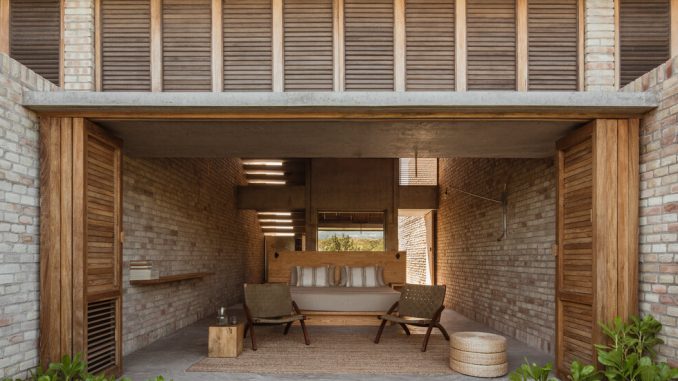
This article is part of our Design special section about making the environment a creative partner in the design of beautiful homes.
When representatives of Grupo Habita asked the architect Alberto Kalach to design an earth-friendly, energy-efficient hotel along the jungle coast of Oaxaca, he knew he would need a few things in return.
The luxury hotel chain, he said, would have to understand that its new outpost needed to be small-scale and low-rise to minimize the destruction of natural vegetation and to reduce the environmental havoc large construction projects can wreak on local lands and water supplies. Mr. Kalach’s sensitive concept for what is now called Hotel Terrestre allowed for just 14 rooms, limiting the property’s profit potential.
Future guests would have to sacrifice, as well, because the hotel had to be entirely solar-powered to avoid the use of fossil fuels. Hotel Terrestre’s rooms have hot water and Wi-Fi, but they run on an energy source limited by the weather, leaving out of the picture hospitality staples like in-room hair dryers and even air-conditioning, not a small ask — at $350 a night — in a location where temperatures can hit the high 80s all year long.
That the architect got his demands is not so surprising. Mr. Kalach is a superstar designer in Mexico, the creative force behind numerous landmark projects, including the acclaimed Vasconcelos Library in Mexico City. His name is a brand.
But his firm is also known for delivering on a bargain, in this case creating a tranquil, seaside oasis that syncs up with the sun and sand around it and that maximizes views of the Pacific Ocean on one side and the Sierra Madre del Sur mountains on the other.
He may have omitted the AC but he gave each of the rooms its own private swimming pool for quick cool-downs. The beach, he noted, is just a few hundred feet away.
“And we orientated the rooms to catch the winds; the breeze coming from the ocean during the day, and the cool air coming from the mountains during the night,” he said. “Air-conditioning represents, like, 8 percent of the contamination of the planet.”
Hotel Terrestre’s goal is to deliver simple pleasures through a low-impact, high-design filter, according to Moisés Micha, a co-founder of Grupo Habita, which operates 15 design-forward hotels in Mexico. “The idea is to work hand-in-hand with nature,” he said.
To that end, the hotel serves as a Mexican beach resort, but with an emphasis on relaxation and wellness instead of margaritas and mariachi bands. There is an on-site restaurant with gourmet food and a separate bar where guests mingle. But it is more of a place to meditate, dip into on-site soaking tubs and walk through the elaborate gardens formed into a maze of succulents and native plants, such as the frangipani that top themselves off with brilliant, white blossoms for a few weeks each spring.
Guests can borrow mountain bikes or take excursions to Oaxaca’s famous mezcal factories, but they are equally inclined to spend romantic evenings watching the sunset and then go to bed on nature’s clock. The hotel, which opened last year, has proved popular with honeymooners.
In one way, Hotel Terrestre is remote. The nearest sizable city is Puerto Escondido, an 18-mile drive away, the first two miles down a dusty dirt road that connects the resort to the coastal highway. In another mile, the area turns posh. Populated by mango groves, cattle ranches and the occasional crocodile, it is steadily developing as a high-end escape and is home to Casa Wabi, a well-known artist’s retreat and cultural center designed by Tadao Ando.
Mr. Kalach kept his design simple and employed “no extra materials that you don’t need,” he said. The aim was to limit the environmental costs of transporting excess goods through mountain roads and loading up landfills.
The main structure, which houses the guest rooms, has very little ornamentation, though it remains dynamic because of exterior masonry walls that step up and back, like stairs rising from the ground. There is a bare-bones, Brutalist edge to the building, though one softened by the texture of the bricks, which are set in various directions and colored in the warm beige, brown and red tones of the local rock from which they were derived.
The building is on two levels: The first is enclosed, with exposed concrete walls and barrel-vaulted ceilings (and custom furniture by the noted designer Oscar Hagerman). The second, which is reached by an exterior staircase, is open-air and has a pool and a small section of roof providing shade while guests take in the scenery.
Those expansive views, and the way the architecture frames them, are the real amenity of Hotel Terrestre, Mr. Kalach said, grand, organic and stunning enough to make guests forget small things like air-conditioning at the peak of summer. Or, at least, that is his hope.
“Every citizen of the world is expecting that somebody else will solve the warming problem, the government, the producers of energy,” he said. “But it is all of us. We all have to change certain ways of behaving.”


Be the first to comment